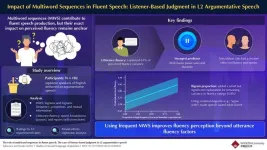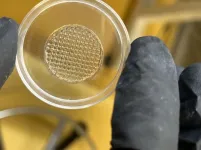(Press-News.org) PULLMAN, Wash. – A new method to recycle wind turbine blades without using harsh chemicals resulted in the recovery of high-strength glass fibers and resins that allowed Washington State University researchers to re-purpose the materials to create stronger plastics.
The innovation provides a simple and environmentally friendly way to recycle wind turbine blades to create useful products.
Reporting in the journal, Resource, Conservation, and Recycling, the team of researchers cut the lightweight material that is commonly used in wind turbine blades, called glass fiber-reinforced polymer (GFRP), into approximately two inch-sized blocks. They then soaked the flakes in a bath of low-toxicity organic salt in pressurized, superheated water for about two hours to break down the material. They then re-purposed its components to make stronger plastics.
“It works very well, especially considering the mild conditions that we applied,” said Cheng Hao, a former graduate student in the School of Mechanical and Materials Engineering and co-first author on the paper. “The solvent is a green solvent, and also the temperature is acceptable for this purpose.”
The GFRP material has traditionally been very difficult to recycle. While thermoplastics, the type of plastic used in milk bottles, can be melted and easily re-used, the glass-fiber composites are typically made with thermosets. These types of composites are cured and can’t easily be undone and returned to their original materials. The first generation of modern wind turbines made of composites from the 1990s are now reaching the end of their lifetimes, creating a significant challenge for disposal. The glass fiber-reinforced material makes up about two-thirds of a wind turbine blade’s total weight. Furthermore, when the blades are made, about 15% of the material is also wasted in manufacturing.
“As wind energy grows, recycling and reusing wind turbine waste is becoming increasingly urgent,” said Jinwen Zhang, corresponding author and a professor in the School of Mechanical and Materials Engineering. “This recycling method is scalable, cost-effective, and environmentally friendly, providing a sustainable solution for reusing large quantities of glass fiber reinforced waste.”
In their work, the researchers soaked the blade material in a mild solution of zinc acetate, which is used in medicines, such as in throat lozenges and food additives. The mild solution allowed the researchers to recover glass fibers and resins in good condition which they then added directly to thermoplastics to produce strong composite materials with up to 70% of the recycled glass fiber materials. Moreover, the researchers were able to recover and reuse most of the catalyzing zinc acetate solution through simple filtration.
“The ease of the catalyst recovery enhances the overall sustainability and cost-effectiveness of the method,” said Zhang, who conducts research in the Composite Materials and Engineering Center.
When the researchers added the recycled material to nylon plastic and tested it, they found that the additional fibers made the nylon more than three times stronger and more than eight times stiffer. They also found that the recycled GFRP material can reinforce other plastics, such as polypropylene and the type of plastics used in milk jugs and shampoo bottles.
“For this work, we didn’t need to fully break down all the bonds and push the reaction to completion,” said Baoming Zhao, co-first author and research assistant professor in the Composite Materials and Engineering Center, “As long as we can break the cross-linked network into smaller pieces, and they are melt processable, we can compound that with nylon and get a new composite. We are not separating the resin from the fiber – we just blend everything with nylon and get a new composite.”
The researchers are continuing studies to make the chemical conditions even easier for recycling by reducing the requirements for pressurization. Working with WSU’s Office of Commercialization they also hope to develop blade materials that are fully recyclable in the first place.
The work was funded by the Department of Energy’s Office of Energy Efficiency and Renewable Energy.
END
Researchers recycle wind turbine blade materials to make improved plastics
2025-04-03
ELSE PRESS RELEASES FROM THIS DATE:
Low neighborhood walkability is associated with increased risk of cardiovascular disease
2025-04-03
Milan, Italy – 3 April 2025. Low neighbourhood walkability is associated with increased risk of cardiovascular disease (CVD), according to research presented today at ESC Preventive Cardiology 2025,1 a scientific congress of the European Society of Cardiology (ESC).
The health benefits of physical activity are well established and yet more than a quarter of adults do not meet the recommended guideline of 150 minutes of moderate-intensity physical activity per week.2 “Neighbourhoods designed ...
Common phrases, not fancy words, make you sound more fluent in a foreign language
2025-04-03
Language learners often assume that using rare, complex vocabulary will make their speech sound more fluent. Research suggests that there is a close relationship between formulaic expression usage in speech and acoustic features of oral fluency. This implies that using formulaic expressions leads to faster articulation speed and fewer disruptions during speech. However, in terms of how listeners perceive speakers’ fluency, the role of formulaic expressions has been unclear.
To investigate this, Ph.D. student, Kotaro Takizawa and Research Assistant Professor Shungo Suzuki from Waseda University, Japan, analyzed speech from 102 Japanese speakers ...
Printed skin to replace animal testing
2025-04-03
Directive 2010/63/EU laid down restrictions on animal testing for the testing of cosmetics and their ingredients throughout the EU. Therefore, there is an intense search for alternatives to test the absorption and toxicity of nanoparticles from cosmetics such as sun creams. A team of researchers from Graz University of Technology (TU Graz) and the Vellore Institute of Technology (VIT) in India is working on the development of skin imitations that mimic the native three-layer tissue structure and biomechanics of human skin. Such imitations can be produced ...
Precision medicine could be possible in the fight against antibiotic resistance
2025-04-03
The first-of-its-kind in-depth bacterial evolutionary map could pave the way for the development of precision treatments for certain antibiotic-resistant infections, such as urinary tract infections.
Researchers at the Wellcome Sanger Institute, the University of Oslo, UiT The Arctic University of Norway, and their collaborators, have developed a new way of using large-scale long-read sequencing data to investigate circular genetic structures called plasmids in the most commonly studied microbe, Escherichia coli (E. coli). Through this, the team were able to track the flow ...
Researchers at the Lewis Katz School of Medicine at Temple University identify new targeted approach to protect neurons against degeneration
2025-04-03
(Philadelphia, PA) – Neurodegenerative conditions such as Parkinson’s disease and Alzheimer’s involve progressive neuronal loss due to disease-induced damage. An enzyme known as dual leucine-zipper kinase (DLK) plays a key role in this process, telling neurons that are damaged or unhealthy when they should cut their losses and self-destruct. Hence, sparing neurons from DLK is an attractive therapeutic strategy that could slow disease progression.
Past attempts to inhibit DLK’s action in human patients, however, led to unexpected side effects affecting the nervous system, suggesting that DLK ...
Western diet causes inflammation, traditional African food protects
2025-04-03
A switch of just two weeks from a traditional African diet to a Western diet causes inflammation, reduces the immune response to pathogens, and activates processes associated with lifestyle diseases. Conversely, an African diet rich in vegetables, fiber, and fermented foods has positive effects. This study, published in Nature Medicine, highlights the significant impact of diet on the immune system and metabolism.
Lifestyle diseases such as cardiovascular diseases, diabetes, and chronic inflammatory conditions are surging across Africa, posing a growing challenge to healthcare systems throughout the continent. Increasing economic ...
Electrochemical method supports nitrogen circular economy
2025-04-03
By Shawn Ballard
Imagine a world where industrial waste isn’t just reduced, it’s turned into something useful. This kind of circular economy is already in the works for carbon. Now, researchers in energy, environmental & chemical engineering at Washington University in St. Louis have developed a promising pathway to convert harmful nitric oxide, a key component of acid rain, into valuable nitric acid, which is used in everyday applications from fertilizer production to metal processing.
Feng Jiao, the Lauren and Lee Fixel Distinguished Professor in the McKelvey School of Engineering at WashU, and collaborators developed a method ...
How researchers are shining a light on kidney disease
2025-04-03
For patients with polycystic kidney disease (PKD), a common genetic disorder that ravages the waste-removing organ with cysts, dialysis and transplantation are among the only treatments.
More than 12.4 million people worldwide suffer from the dominant form of the condition. Now, Rutgers University geneticists have uncovered fresh details of how the disease progresses – findings that could open the door to new therapies.
In a study published in Nature Communications, Inna Nikonorova, a research assistant professor in the Department of Genetics within the Rutgers School of Arts and Sciences, reports on a novel way to identify and track material carried ...
Some gut bacteria could make certain drugs less effective
2025-04-03
A new study, published today in Nature Chemistry by researchers from the University of Pittsburgh and Yale University, shows how common gut bacteria can metabolize certain oral medications that target cellular receptors called GPCRs, potentially rendering these important drugs less effective.
Drugs that act on GPCRs, or G protein-coupled receptors, include more than 400 medications approved by the U.S. Food and Drug Administration (FDA) for treatment of many common conditions such as migraines, depression, type 2 diabetes, prostate cancer and more.
“Understanding how GPCR-targeted drugs interact with human gut microbiota is critical for advancing ...
PEPITEM sequence shows effects in psoriasis, comparable to steroid cream
2025-04-03
Birmingham scientists have shown that a sequence of just three amino acids may reduce the severity of psoriasis, when applied topically in an emollient cream.
The researchers, whose study is published in Pharmacological Research, identified the smallest part of a peptide (small protein) called PEPITEM, which occurs naturally in the body and regulates inflammation.
The study also showed that both PEPITEM and the three amino acid (tripeptide) sequence delivered a significant reduction in the severity of psoriasis, that is comparable to a steroid cream.
Psoriasis ...



